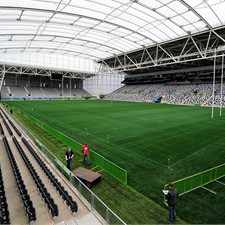Dunedin's 'Toaster' ready to pop
Friday 9 September 2011, 9:04PM
835 views

England and Argentina will step into the future at the state-of-the-art Otago Stadium for their opening Pool B Rugby World Cup 2011 match on Saturday.
One of the most eagerly-anticipated pool encounters of the tournament will take in the revolutionary venue which has already been dubbed the 'Toaster'.
It will be the first international game at the NZ$194million stadium, the first to feature real turf under a permanent roof.
The greatest stadiums in the world are often described as cauldrons, but this one has a lid. Walking in and gaping up at the stands, this will undoubtedly be one of the most atmospheric venues at the RWC.
Seating is steep and close to the touchline and, while the architects insist the roof is "acoustically transparent", a test event match between Otago and Canterbury generated huge noise rom a half-capacity crowd of 15,000.
Darren Burden, who has spent five years on the project from initial assessments on whether to renovate the much-loved Carisbrook Stadium to the final touches still being made on the eve of kick-off, believes fans and players are about to experience something unique.
Stunning spectacle
"We're extremely fortunate that it's one of the biggest pool games," said Burden, the venue's operations director.
"There's going to be a worldwide audience to showcase this stunning new stadium and the world is going to sit up and take notice."
One thing that won't be broadcast is the spectacle of rugby balls bouncing back off the ceiling.
Smaller than grounds such as Cardiff''s Millennium Stadium, which has a sliding roof, the 37-metre high ceiling still beats the highest recorded kick by more than seven metres – the equivalent of about three Simon Shaws.
"There was some nervousness from coaches and players about whether up-and-unders would hit the roof," Burden said.
"We got a geospatial researcher in to test how high balls were being kicked, and contacted manufacturers to see if it was likely that balls in future would go higher.
"Nobody's got close to hitting it yet, but having the Argentines here on Saturday will be a good test."
Ventilated and transparent
Made of a Teflon by-product called ETFE, the roof consists of membranes filled with air to make a series of rugby ball-shaped pillows.
It can bear the weight of a car and lets in 94 per cent of sunlight, compared to 65 per cent for glass, so that the grass can photosynthesise.
The stands are also ventilated to give the pitch oxygen and conditions are constantly monitored. Fans will experience a temperature a few degrees higher than across the city at Carisbrook.
The Stadium's North Stand is also lower than the opposite tiers so that the pitch, which is interwoven with polypropylene strands to help it weather scrums, gets sunlight all day.
In the past, England have occasionally benefited from downpours during matches, particularly against southern hemisphere sides, but Dunedin's permanent roof has dashed the elements having any impact.
"We went to have a look and it's a great surface," said England assistant coach Graham Rowntree.
"We can play in any conditions. We're not crying for rain at the weekend, because we won't get it, will we."